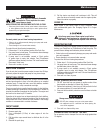
21
Fuel and its vapors are extremely flammable
and explosive. Fire or explosion can cause
severe burns or death.
WHEN STORING FUEL OR EQUIPMENT WITH FUEL IN TANK
• Store away from furnaces, stoves, water heaters, clothes dryers,
or other appliances that have pilot light or other ignition source
because they can ignite fuel vapors.
WINTER STORAGE
NOTE:
You must protect your unit from freezing temperatures.
• Failure to do so will permanently damage your pump and render
your unit inoperable.
• Freeze damage is not covered under warranty.
To protect the unit from freezing temperatures:
1. Follow steps 1-3 in the previous section After Each Use.
2. Use pump saver to treat pump. This minimizes freeze damage
and lubricates pistons and seals.
3. If pump saver is not available, connect a 3-foot section
of garden hose to water inlet adapter. Pour RV-antifreeze
(antifreeze without alcohol) into hose. Pull recoil handle twice.
Disconnect 3-foot hose.
4. Store unit in a clean, dry area.
LONG TERM STORAGE
If you do not plan to use the power washer for more than 30 days,
you must prepare the engine and pump for long term storage.
PROTECT FUEL SYSTEM
Fuel can become stale when stored over 30 days. Stale fuel causes
acid and gum deposits to form in the fuel system or on essential
carburetor parts. To keep fuel fresh, use a fuel stabilizer, available
as a liquid additive or a drip concentrate cartridge.
There is no need to drain gasoline from the engine if a fuel stabilizer
is added according to instructions. Run the engine for 2 minutes to
circulate the stabilizer throughout the fuel system. The engine and
fuel can then be stored up to 24 months.
If gasoline in the engine has not been treated with a fuel stabilizer,
it must be drained into an approved container. Run the engine until
it stops from lack of fuel. The use of a fuel stabilizer in the storage
container is recommended to maintain freshness.
PROTECT ENGINE
1. Change engine oil.
2. Remove spark plug.
3. Pour a tablespoon (5-10cc) of clean engine oil into the
cylinder.
4. Pull the starter rope several times to distribute the oil in the
cylinder.
5. Reinstall the spark plug.
6. Pull the starter rope slowly until resistance is felt. This will
close the valves so moisture cannot enter the engine cylinder.
Return the starter rope gently.
CHANGE OIL
While engine is still warm, drain oil from crankcase. Refill
with recommended grade. See Changing Engine Oil in Engine
Maintenance.
Hot oil may cause burns. Allow engine to cool before
draining oil. Avoid prolonged or repeated skin exposure
with used oil. Thoroughly wash exposed areas with soap.
PROTECTING THE PUMP
To protect the pump from damage caused by mineral deposits or
freezing, use PumpSaver or RV-antifreeze to treat the pump. This
prevents freeze damage and lubricates pistons and seals.
• Failure to do so will permanently damage your pump and render
your unit inoperable.
• Freeze damage is not covered under warranty.
To protect the unit from freezing temperatures:
1. Follow steps 1-3 in the previous section After Each Use.
2. Use pump saver to treat pump. This minimizes freeze damage
and lubricates pistons and seals.
3. If pump saver is not available, connect a 3-foot section
of garden hose to water inlet adapter. Pour RV-antifreeze
(antifreeze without alcohol) into hose. Pull recoil handle twice.
Disconnect 3-foot hose.
4. Store unit in a clean, dry area.
OTHER STORAGE INSTRUCTIONS
1. DO NOT store fuel from one season to another unless it has
been treated as described in Protect Fuel System.
2. Replace fuel container if it starts to rust. Rust and/or dirt in fuel
can cause problems if it’s used with this unit.
3. Cover unit with a suitable protective cover that does not retain
moisture.
Storage covers can be flammable.
• DO NOT place a storage cover over a hot power washer.
• Let equipment cool for a sufficient time before placing the
cover on the equipment.
4. Store unit in a clean and dry area.
TRANSPORTING/TIPPING OF THE UNIT
Do not operate, store or transport the unit at an angle greater than
15 degrees.
Maintenance


















